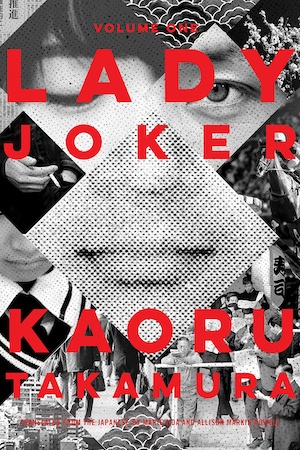Translated by Allison Markin Powell and Marie Iida — Lady Joker, Kaoru Takamura’s 1997 epic and the first of her novels to be translated into English, is part crime fiction and part social commentary. The publication in Japan came at a turning point in the author’s career, moving from crime fiction to literary fiction. Lady Joker is so large in scale that it required two translators, and has been published in two volumes, with the second due in 2022. It’s epic.
From the opening chapters, Lady Joker feels like two stories. The first is a tale of post-war hardship, told through news reports and letters referring to mass lay-offs at Hinode Beer, a fictional Japanese company whose name is a pun on one of Japan’s major brewers. The second is the story of a rag-tag collection of down-and-out men gathered at a Tokyo racecourse in 1995, partaking in one of the few types of gambling legal in Japan. Both these threads are really about people struggling against their society, the boom times Japan enjoyed forever lost. In both there is also a desire for revenge.
The men who gather at the racetrack are a catalogue of those pushed to the margins of Japanese society. There’s a Zainichi Kankokujin, a Korean living in Japan; an ex-soldier turned single father of a daughter with a disability; a recently-demoted detective; an injured labourer; and a nihilistic banker. These men are the dregs of society, until they band together, inspired by a letter from 1947 referring to the lay-offs at Hinode Beer. The men come together to exact revenge on Hinode for the company’s treatment of its employees, particularly those in the Burakumin community, Japan’s historic caste of untouchables, who still face discrimination today.
Readers who are unaware of social discrimination in Japan may find themselves shocked and surprised by Lady Joker and its depiction of the stratification of Japanese society. Because of its size, Lady Joker is able to tell this story in great depth by giving a fictionalised version of one of Japan’s most famous unsolved cases, an extortion case involving the kidnapping of the president of one of Japan’s largest confectionery companies in the 1980s. But you don’t need to know this aspect of Japanese history in order to enjoy Lady Joker; by presenting both the world of the corrupt corporations and the world of the down-and-outs, as well as the third perspective of the police, Lady Joker gives the full story. Simply put, because of its scope Lady Joker is able to go into more depth than most others.
In the end how much you enjoy Lady Joker will depend on how much sympathy you feel for the characters. There are 27 named characters, set out as dramatis personae in the opening pages. The inner workings of the police, corporations and newspaper companies are examined in great depth, detailing how the corruption, cronyism and Yakuza links that permeate every level of Japanese society work together to grind down the men at the racetrack. A detailed account of corporate malfeasance might not be for everyone, but it sets the scene for the act of revenge carried out by Seizo Monoi and his disaffected colleagues.
Each of these characters is explored in depth in chapters narrated from alternating perspectives. There are elements of police procedural in the investigation of the kidnapping, and elements of social and psychological drama in the vengeance sought by the outcast men gathering at the racetrack. If you can commit yourself to over a thousand pages, half of which are not to be published until 2022, you will find a lot to love in Lady Joker, with its shifting structure and range and depth of characterisation.
Lady Joker’s structure is not what Western readers might expect from a crime novel. There’s little focus on action, and much more on build up and background. A lot is put into cracking up the tension, and yet Part One ends abruptly, without a cliffhanger and with quite a few unanswered questions. The real life crime that Lady Joker is based on remains unsolved to this day, but I get the feeling Lady Joker Volume Two will have a greater sense of closure.
Japanese fiction has grown in stature and popularity outside Japan in recent years, which has meant that translators and publishers have been able to produce and publish more ambitious works – books that are longer, deeper and weirder than the norm. Novels like Bullet Train add to a recent glut of Japanese crime fiction which stretches from the twisted, perfectly timed plots of Keigo Higashino to the social commentary of Hideo Yokoyama. Lady Joker fits somewhere in between, an ambitious work of carefully plotted crime fiction with a deep social conscience.
Soho Crime
Print/Kindle/iBook
£7.29
CFL Rating: 5 Stars
